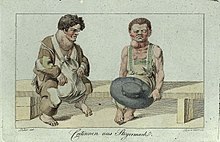Goitre
[4] Hypothyroid people commonly have poor appetite, cold intolerance, constipation, lethargy and may undergo weight gain.[6] Goitre can also result from cyanide poisoning, which is particularly common in tropical countries where people eat the cyanide-rich cassava root as the staple food.[19] The discovery of iodine's importance in thyroid function and its role in preventing goiter marked a significant medical breakthrough.The introduction of iodized salt in the early 20th century became a key public health initiative, effectively reducing the prevalence of goiter in previously affected regions.Before iodine enrichment programs, goiters were common in areas with repeated flooding or glacial activities, which erodes the topsoil.[24] Chinese physicians of the Tang dynasty (618–907) were the first to successfully treat patients with goitre by using the iodine-rich thyroid gland of animals such as sheep and pigs—in raw, pill, or powdered form.[25] In the 12th century, Zayn al-Din al-Jurjani, a Persian physician, provided the first description of Graves' disease after noting the association of goitre and a displacement of the eye known as exophthalmos in his Thesaurus of the Shah of Khwarazm, the major medical dictionary of its time.[37] The coat of arms and crest of Die Kröpfner, of Tyrol, showed a man "afflicted with a large goitre", an apparent pun on the German for the word ("Kropf").[42] Goiter, resulting primarily from iodine deficiency, has historically been a widespread condition with significant health and social implications.

no data
fewer than 50
50–100
100–150
150–200
200–250
250–300
300–350
350–400
400–450
450–500
500–800
more than 800


hyperplasiathyroidSpecialtyEndocrinologyIodine deficiencyautoimmune diseasetumorscyanide poisoningthyroid glandthroatcancerousbenignhypothyroidismhyperthyroidismadrenergictachycardiapalpitationstremorincreased blood pressureheat intolerancehypermetabolismthyroid hormoneexophthalmoscold intoleranceconstipationlethargynon-specificiodized saltSelenium deficiencyHashimoto's thyroiditiscassavaCongenital hypothyroidismInborn errorsthyroid hormone synthesisGoitrogenAdverse drug reactionslymphocyteslobulatedThyroid hormone replacementPituitary diseasethyroid stimulating hormoneGraves' diseaseAutoantibodiesAntithyroid agentsradioiodineThyroiditisinflammationThyroid cancer5-year survival ratethyroid neoplasmsThyroid hormone insensitivitySarcoidosisAmyloidosisHydatidiform moleAcromegalyPendred syndrometoxic adenomathyroid function testthyroid noduletoxic multinodular goitrepalpationsternumthyroid hormonesradioactive iodineiodideLugol's iodineKI solutionthyroidectomyDisability-adjusted life yeartopsoilGreat Lakes basinPemberton Meadowscongenital iodine deficiency syndromeStyriaTang dynastysargassumZayn al-Din al-JurjaniPersian physicianRobert James GravesKarl Adolph von BasedowCaleb Hillier ParryEdward JennerParacelsusIodineBernard CourtoisEnglish MidlandsUnited StatesAppalachianGreat LakesMidwestIntermountaintable saltsupplemented with iodineCentral AsiaCentral AfricatrachtMiesbachSalzburgchokerGeorge H. W. BushBarbara Bushcardiac dysrhythmiaGermanDavid MarineEndemic goitreStruma ovariiteratomaThyroid hormone receptorWho Named It?The New York TimesLahita RGFox-Davies ACDiseasesDBMedlinePlusThyroid diseaseCretinismMyxedemaMyxedema comaEuthyroid sick syndromeVan Wyk-Grumbach syndromeQueen Anne's signWoltman signMyoedemaThyroid dyshormonogenesisPickardt syndromeHoffmann syndrome